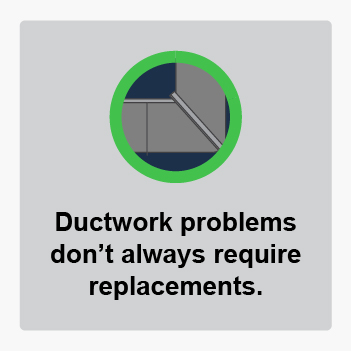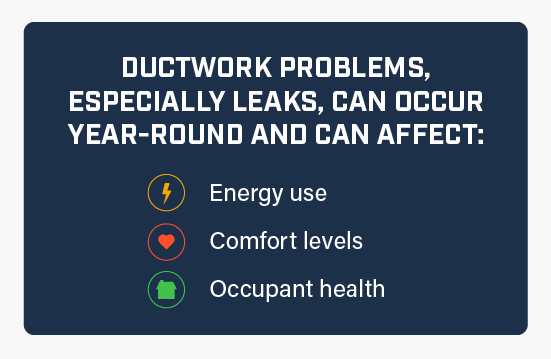Do You Need to Replace Your Residential Ducts?
The ducts in your home may be tucked away behind walls, under floors, in ceilings, or crawlspaces. Because you don’t see your home’s ductwork often, they’re easy to forget about until they affect the comfort levels in your home. Defective ductwork not only makes rooms feel stuffy, they can lower the quality of indoor air and increase energy costs each month. By recognizing the signs of duct-related problems, you’ll take strides in improving the health of your home and its energy use.
The Impact of Ducts in Your Home
Ductwork used in HVAC systems removes and delivers air throughout a home. Heating and cooling ducts, or supply ducts, send conditioned air into the rooms of your home to maintain comfortable temperatures. In general, one end of the duct is connected to the HVAC unit, and the other ends connect to the registers in each room. Return air ducts re-circulate the air in a home. After conditioned air enters a room, a blower fan cycles it back through the HVAC system via the return ducts, which are connected to larger vents.
Ductwork problems, especially leaks, can occur year-round and can affect:
- Energy use: A damaged, improperly designed, or leaky duct may cause air to enter unoccupied areas in the home, such as the attic or spaces between the walls. As a result, an HVAC system might have to work up to 40 percent harder to maintain comfortable temperatures.
- Comfort levels: Faulty ductwork can make rooms feel hotter and more humid during the summer, and too cold in the winter. Similarly, the temperatures throughout your home might not feel consistent because the ducts can’t blow conditioned air evenly into each room.
- Occupant health: Air leaks in ductwork may contain fumes from household products, insulation particles, dust, mold, and other allergens. The substances can trigger allergy symptoms in home occupants, which can be dangerous for those with upper respiratory conditions, such as asthma.
Signs You Should Replace Your Home’s Ducts
Ductwork problems don’t always require replacements. A licensed HVAC contractor that specializes in ductwork can perform tests to help determine the best course of action for your home’s system.
Signs that you might need a replacement include:
- Improper duct design: In addition to leaks, improperly designed ductwork is one of the leading causes of HVAC energy losses because the system can’t circulate air to heat or cool your home efficiently or effectively. Even if the HVAC equipment is the right size, inadequate duct design can prevent its proper function.
- Crushed, torn, twisted, or kinked flexible ductwork: Flexible plastic ducts are commonly used in homes. Because the material is not rigid, it is vulnerable to becoming damaged beyond repair, which restricts airflow or diverts it to unoccupied spaces.
- Mold: Common symptoms of duct leaks are excess dust and musty odors in a room caused by mold. If mold infiltrates ductwork, it could send spores into your home. For the sake of your health, it’s best to replace mold-infested ducts.
- Age: Ducts and their seals, joints, and seams can deteriorate in as little as 10 years. If the ductwork in your home is more than a decade old and causes energy, comfort or health problems, a replacement might be the best course of action.
Replacing Your Home’s Ductwork
Many homeowners want to know how to replace HVAC ductwork. While replacing ductwork can be done as a project on your own, it is extensive and requires some prior knowledge of how your works, the previous installation, and more. Because of that, it’s best done with the help of experienced contractors like AAA Heating & Cooling.
How to Replace HVAC Ductwork
As a general overview, here are the steps needed when replacing your home’s HVAC ductwork.
- Dismantle sheet metal ductwork: Once you’ve located the ductwork, begin by unscrewing and dismantling the sheet metal around the duct’s circumference. Be sure to save sheet metal that can be reused for new duct installation.
- Remove flexible ductwork: After the sheet metal is dismantled, remove the flexible ductwork.
- Dispose of old materials: Properly discart old ductwork, broken fiberglass, and any other old, unusable pieces.
- Install new ductwork: Once old ductwork is removed, install new ducts per manufacturer instructions.
- Seal ductwork: Ensure there are proper seals on your new ductwork to remove any airloss. Seal joints with metal-backed tape or mastic gum.
- Check the system’s airflow: Once your ductwork is in place run a final check to ensure your unit’s airflow levels are efficient.
Planning Residential Duct Maintenance
When your HVAC system and thermostat work well, but you experience any of the problems below, call a licensed expert to schedule a duct inspection and blower test:
- The air in your home feels muggy during the summer
- The air in your home feels too dry during the winter
- Some rooms feel warmer or cooler than the others throughout the year
- Your energy bills keeps getting more expensive
- You notice musty odors and can’t find the source
- Your home seems excessively dusty
- Those with allergies and asthma notice an increase in symptoms while inside
HVAC specialists not only can help you identify problems with your residential ductwork, but they can also get you set up with preventative maintenance plans that can help you maintain your ductwork.
Improve the Efficiency of Your Home’s Duct System With AAA Heating & Cooling
To learn if a duct replacement is right for your home comfort needs or to schedule duct cleaning or inspection, contact AAA Heating and Cooling. We also have a variety of duct cleaning resources for more information about residential duct systems.
